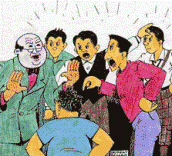Money Myth Exploded – based on an article by Louis Even (1885-1974)
Five men are marooned on an island and build up a successful society, with each working his trade. Between them they provide crops, meat, carpentry, stone and metals and barter with each other to share their efforts and produce.
They miss the convenience of paper money to help them trade with each other, but that need is met with the arrival of a banker who survived from another shipwreck.
The banker has with him a printing press and a barrel of gold to back his currency. Thus the men are delighted at the prospect of having money in their hands. They each do their best to please the banker who holds the tantalising power of money. Meanwhile the banker buries his barrel of gold where none of the men will find it.
The banker prints 1,000 notes with a face value of $1 and the banker then provides each man with $200. But first he has them sign an agreement that they will pay the money back with 8% interest at the end of the year. This is to pay him for providing the money that is backed by his barrel of gold. They each happily accept the terms, since they delight in the privilege of having money in their pockets.
Trading accelerates and productivity is high. All are happy with the new situation.
However, as the year comes to a close they realise that it is impossible to pay back the $200 capital and the $16 interest that each person owes. The banker only produced $1,000 in notes and yet he requires $1,080 in payments.
When the men challenge the banker about this impossible situation the banker agrees to accept only the interest payment, which they certainly can pay.
The banker encourages them to organise a national system where each man is levied a tax to ensure the money is available to pay the interest. Those who have more will be taxed more.
As the men follow the banker’s advice he exults in the control he is now wielding over the whole community. He effectively owns all their assets and controls their lives.
The new system of taxes causes the men to compensate by putting up their prices and reducing their purchases to preserve money. They also begin to resent their situation, taking less interest in their work, arguing for more pay and trying to squeeze money out of each other. Ill-will develops between the “haves” and the “have nots”.
The banker’s interest-only solution turns sour when the men realise that in time they will have paid all their money to the banker and still owe him the initial capital.
When the men challenge the banker yet again about their desperate situation he offers to extend more credit to them, so they can have money to make the next payments. The men realise that such an arrangement leads to spiralling debt. But there seems to be no solution.
To protect his place of control over the community, the banker promotes political division, printing two newspapers. One paper tells the conservatives that the radicals cause the problems, while the other paper informs the radicals that the conservatives are the problem. By maintaining division the banker is protected against a unified rejection of his controlling influence.
The men are saved by the discovery of a book about Social Credit. It explains that wealth is created by productivity, not by debt. When the society increases its productivity and creates more goods, then new wealth is created.
Rather than borrowing money from someone who guarantees it with gold, the society can give each person a share of the social wealth, as a Social Credit in an account.
As the men trade among themselves accounting records can be kept to track their personal account. As the society’s wealth is built up, such as by improved infrastructure and increased goods, each person can receive a dividend payout, by new credit put into their account.
If someone needs funds to develop a new project the society can give him an advance of Credit which is paid back from the proceeds of the new development.
As the men come to understand this simple, alternative way of providing for trade among each other they now see the dangers of the banker’s debt based money.
They decide to confront the banker and to banish him from the island. They refuse to give him interest on the money he printed, since he did not actually create new value and does not deserve anything more than what he created.
As the men help the banker dig up his barrel of gold they discover that the barrel contains nothing more than rocks. There was no gold backing the paper money. The men had been duped by their fascination for gold and for money itself.
The men are eventually rescued from the island and they take with them a firm commitment to extend the idea of Social Credit as the truly viable alternative to the debt based banking system.
Scottish engineer Clifford Hugh Douglas (1879-1952) developed the concept of Social Credit following his experiences in India in 1908 where major development projects were restricted by limited money. Other similar experiences following and by 1918 he began propounding the idea of Social Credit as a way of getting projects funded.
Louis Even (1885-1974) wrote Money Myth Exploded to help explain the Social Credit concept in a short booklet form. The full version, with cartoon images, can be read at JeremyLee.com.au. http://www.jeremylee.com.au
